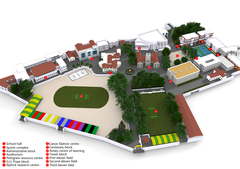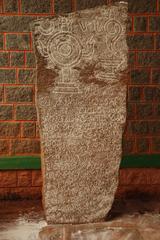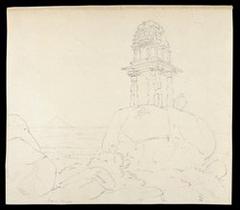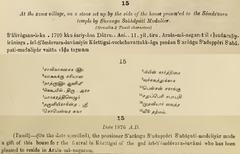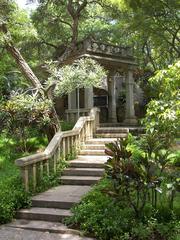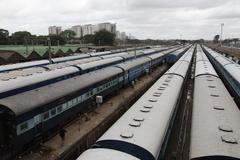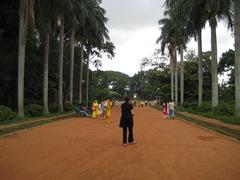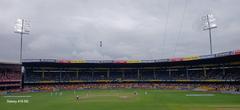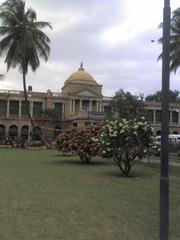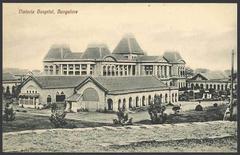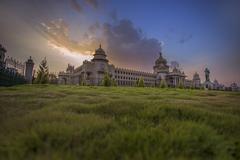
Bangalore Town Hall Visiting Hours, Tickets, and Historical Guide
Date: 04/07/2025
Introduction
Bangalore Town Hall, officially named Sir K.P. Puttanna Chetty Town Hall, is a monumental landmark in the heart of Bengaluru, Karnataka. Renowned for its neoclassical architecture and civic significance, it stands as a testament to the city’s transition from colonial heritage to modern metropolis. Since its inauguration in 1935, the Town Hall has served as a central venue for public gatherings, cultural performances, political rallies, and social reform movements—making it a vibrant symbol of Bangalore’s communal spirit and urban evolution (Wikipedia; Incredible India).
Strategically located at the intersection of J.C. Road and Kasturba Road, and within walking distance of iconic sites like KR Market and Cubbon Park, Bangalore Town Hall is not only an architectural marvel but also an ideal starting point for exploring the city’s historic core (indiatourism.travel; LBB). This comprehensive guide presents the Town Hall’s history, architecture, visitor information—including hours, tickets, and accessibility—nearby attractions, and practical tips for visitors.
Historical Overview
Early Urban Development and Colonial Influence
Bengaluru’s transformation from a modest settlement to a major urban center is reflected in its historic landmarks. The foundations were laid during the Ganga Dynasty in the 9th century, followed by rule under the Vijayanagara Empire, Mughals, and British colonial authority. The British era brought significant infrastructural advancements, including the construction of civic buildings in neoclassical and European styles—setting the stage for the Town Hall’s creation (The Hosteller).
Conception and Construction
Commissioned during a wave of urban reform and expansion, the Town Hall’s construction began in the early 1930s and was completed in 1935. Sir K.P. Puttanna Chetty, the first president of the Bangalore City Municipality and a noted philanthropist, was honored in its naming (India Video). The building was designed by Sir Mirza Ismail, the then Diwan of Mysore, renowned for his contributions to the city’s civic development (LBB).
Architectural Significance
Style and Key Features
Bangalore Town Hall is a prime example of neoclassical architecture. Its grand portico, approached by a wide flight of steps, is supported by imposing Tuscan columns and crowned by a triangular pediment—a visual anchor reminiscent of ancient Greek and Roman temples. The symmetrical façade, stone construction, and elegant arched doorways enhance its stately presence (Wikipedia; Incredible India).
Columns and Ornamentation
The main portico’s Tuscan columns and the side porticoes’ Corinthian columns create a sense of classical grandeur. Ornate cornices, floral motifs, and meticulously carved moldings highlight the building’s decorative finesse, while large arched windows ensure natural light and visual openness.
Interior and Auditorium
At the core is a spacious auditorium with a seating capacity of over 1,000, featuring wooden flooring and ornate ceilings for optimal acoustics and aesthetic appeal. The interior design balances formality with warmth, making it suitable for a variety of cultural and civic events (Incredible India).
Materials and Renovations
Constructed primarily from locally sourced stone, the Town Hall’s white exterior conveys both durability and elegance. Significant renovations have modernized its facilities, including upgrades to acoustics, lighting, and seating while preserving its heritage (Karnataka.com; Wikipedia).
Civic and Cultural Role
Since its opening, the Town Hall has been central to Bengaluru’s civic life. It has hosted municipal meetings, independence-era rallies, performing arts festivals, and literary gatherings. The hall has welcomed legendary artists and public figures, and continues to be a preferred venue for cultural celebrations and community engagement (indiatourism.travel; LBB).
The steps and portico are iconic backdrops for rallies, peaceful protests, and official ceremonies. The Town Hall’s ongoing relevance is seen in its regular hosting of contemporary performances, exhibitions, and social campaigns.
Visitor Information
Location and Getting There
- Address: Intersection of J.C. Road and Kasturba Road, Sudham Nagar, Bengaluru
- Metro: Sir M. Visvesvaraya Metro Station (Purple Line), ~10-minute walk (VisitBangalore.in)
- Bus: BMTC stops at Town Hall, Corporation Circle, and K.R. Market
- Rail: Bangalore City Railway Station (Krantivira Sangolli Rayanna), ~3 km away
- Taxi/Auto: Ola, Uber, and autos available; parking is limited
Visiting Hours
- General Public: Open for events, exhibitions, and performances—primarily evenings and weekends
- Typical Hours: 10:00 AM to 6:00 PM, but access depends on scheduled activities
- Closed: Mondays and some public holidays; check schedules ahead
Tickets
- Entry: Free for general public during open hours; event tickets may apply
- Purchase: At venue or via authorized online platforms, per event
Accessibility
- Wheelchair Access: Ramps and accessible restrooms available; contact administration for special needs
- Facilities: Restrooms on-site; no food courts, but local eateries nearby (VisitBangalore.in)
Photography and Etiquette
- Photography permitted in public areas unless restricted for specific events
- Modest attire and punctuality recommended
Nearby Attractions
Explore a variety of historic and cultural sites within walking distance, including:
- Lal Bagh Botanical Garden: Renowned for its glasshouse and rare flora (Trek Zone)
- Tipu Sultan’s Summer Palace: A prime example of Indo-Islamic architecture
- Bangalore Fort: Historic remnants dating to 1537
- Karnataka Government Museum: One of India’s oldest museums
- Avenue Road: Famous for bookstores and traditional markets
Best Time to Visit
The ideal period is from October to February, coinciding with Bangalore’s cultural season and pleasant weather. The Town Hall is active year-round but check for rain during monsoon months (Tripoto).
Special Events and Guided Tours
- Events: Check local listings for performances, exhibitions, and festivals (thehaatofart.com)
- Guided Tours: Available on request for groups; contact management in advance
- Heritage Walks: Town Hall is a highlight in many city heritage tours
Frequently Asked Questions (FAQs)
Q: What are the Bangalore Town Hall visiting hours?
A: Access is generally during public events, mostly in the evenings or weekends; typical open hours are 10:00 AM to 6:00 PM.
Q: Is there an entry fee or tickets required?
A: Entry is free for general visits; ticketing applies for special events.
Q: Is the Town Hall wheelchair accessible?
A: Yes, basic accessibility features are present; contact administration for assistance.
Q: Are guided tours available?
A: Group tours can be arranged; regular tours are not common.
Q: What are the best nearby historical sites?
A: Lal Bagh, Tipu Sultan’s Summer Palace, Bangalore Fort, and Karnataka Government Museum.
Summary
Bangalore Town Hall exemplifies Bengaluru’s architectural grandeur and civic heritage. Its neoclassical design, vibrant event calendar, and proximity to major attractions make it a must-visit destination for history buffs and cultural enthusiasts. Plan your visit around scheduled events, explore nearby heritage sites, and immerse yourself in the city’s living history. For up-to-date information, follow event calendars and consider downloading the Audiala app for curated cultural experiences.
References
- Bangalore Town Hall, Wikipedia
- Puttanna Chetty Town Hall, Incredible India
- Best Historical Buildings in Bangalore, LBB
- Bangalore Town Hall, India Video
- Bengaluru Historical Sites, India Tourism
- Visit Bangalore – Town Hall Guide
- Cultural Events, The Haat of Art
- Town Hall History, Trek Zone
- Bangalore Town Hall’s 80th Anniversary, Karnataka.com
- Tripoto Bangalore Guide
- Audiala App


